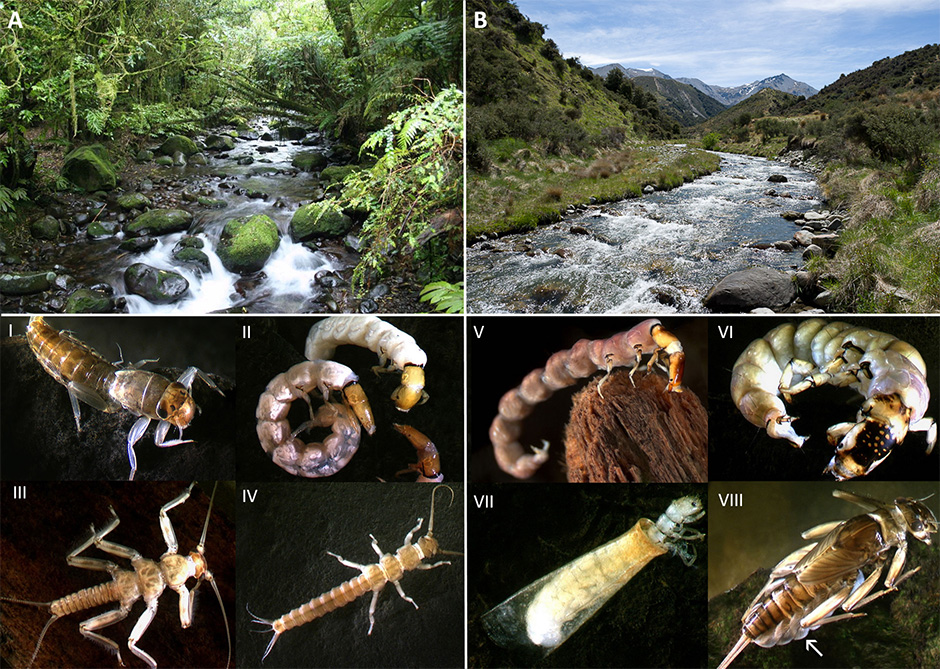
Forested streams are characterised by eDNA from several widespread insect lineages that are rare or absent from deforested habitats, including grazing mayfly (Neozephlebia; i) and stonefly (Zelandoperla; iii), the filtering caddis Hydrobiosella (ii), and the shredding stonefly Austroperla (iv). By contrast, deforested streams now house a distinctive assemblage of insects that are rare or absent from forested ecosystems such as caddisflies Psilochorema (v), Costachorema (vi), grazing Hydroptilidae (vii) and Deleatidium (viii).
Photo: Manaaki Whenua Landcare Research.
Deforestation of Aotearoa New Zealand resulted in dramatic biological shifts in freshwater ecosystems, University of Otago research has found.
Published in Science of the Total Environment, the study used more than 100 freshwater environmental DNA (eDNA) samples from across Otago and Southland to compare the biodiversity between forested and deforested streams.
Focusing on about 100 species of ecologically important freshwater insects, such as mayflies and stoneflies, the Department of Zoology researchers found a distinct insect group linked to forest loss.

Professor Jon Waters.
Lead author Professor Jon Waters was surprised by how substantially and predictably the forested and deforested eDNA samples differed.
“We could easily tell whether a stream was forested or deforested just from looking at the insect eDNA data.
“Deforestation clearly has had major impacts on the diversity of species present in our rivers, and also on ecosystem function, with several key forest species now being rare or absent in deforested regions,” he says.
The study is important as freshwater quality and biodiversity are significant environmental issues, both here and overseas.
“New Zealand was fully forested before humans arrived just a few centuries ago. With only a quarter of the original cover left, the associated environmental impacts have been severe, and degradation of our waterways has been widespread.
“One major concern relates to the loss of wetland vegetation cover and its potential effects on freshwater ecosystem health.”
As efforts turn to mitigate these impacts and restore freshwater ecosystems, Professor Waters believes eDNA represents a key tool for efficiently and rapidly monitoring ecosystem-wide health, and for testing the success of restoration efforts.
“eDNA is important for detecting the presence of organisms within particular regions, with a famous example being the detection of viruses in wastewater.
“In the same way, we are now using eDNA to assess the diversity of species within our ecosystems, for instance, to compare the species found in natural versus degraded waterways.”
Publication details:
Freshwater eDNA reveals dramatic biological shifts linked to deforestation of New Zealand
Jonathan M Waters, Steven Ni, Graham A McCulloch
Science of the Total Environment
For more information, contact:
Professor Jonathan Waters
Department of Zoology
University of Otago
Email jon.waters@otago.ac.nz
Ellie Rowley
Communications Adviser
University of Otago
Mob +64 21 278 8200
Email ellie.rowley@otago.ac.nz
